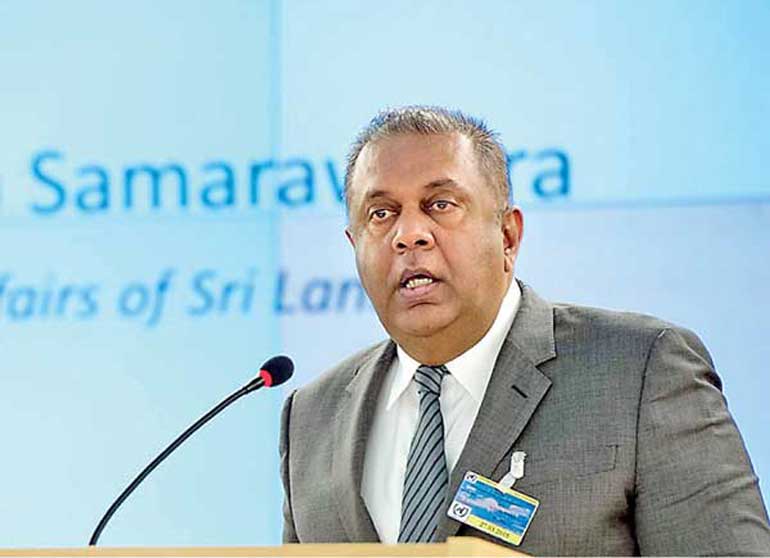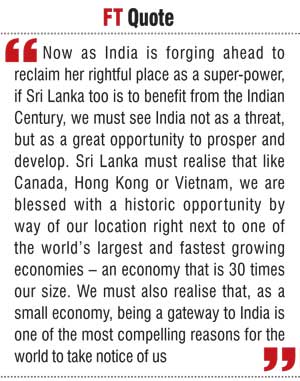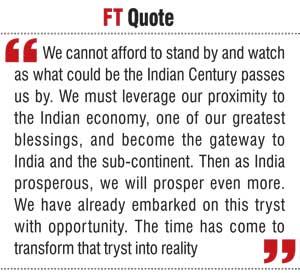Monday Mar 17, 2025
Monday Mar 17, 2025
Thursday, 4 February 2016 00:00 - - {{hitsCtrl.values.hits}}
 Foreign Affairs Minister Mangala Samaraweera
Foreign Affairs Minister Mangala Samaraweera
Sri Lanka’s neo-fascists are in eternal fear of Indians swarming into the island to take over the jobs and market and this kind of “muddled thinking” does not do justice to the majority of the country, the Foreign Affairs Minister Mangala Samaraweera said.
“These neo-fascists seem to see an Indian under every bus and live in eternal fear of Indians swarming into Sri Lanka,” Minister Samaraweera told the Sri Lanka-India Society, delivering a speech on Sunday in Colombo.
“Whenever a bridge over the Palk Straits to connect our two nations is proposed, they get into a paranoid frenzy that all of India is waiting drive over that bridge and make Sri Lanka their home; when trade agreements are discussed, they see swarms of Indian doctors and barbers coming across to flood the Sri Lankan market. Now they claim that their IT specialists are all waiting to come and take the jobs of Sri Lankan engineers.”
He said this “insecure, reactionary and muddled thinking” does not do justice to the Sinhalese race’s great and long history, nor does it do justice to the gentle, compassionate and moderate majority of this country.
Following is the full text of Foreign Minister Samaraweera’s speech:
 Thank you very much, Mr. President, for inviting me to give this talk at a very propitious time for Indo-Lanka relations. In fact, the last year has been an excellent year for further cementing our friendship, which my predecessor said had already reached a state of irreversible excellence.
Thank you very much, Mr. President, for inviting me to give this talk at a very propitious time for Indo-Lanka relations. In fact, the last year has been an excellent year for further cementing our friendship, which my predecessor said had already reached a state of irreversible excellence.
We had the opportunity of welcoming the Prime Minister of India to Sri Lanka, while the President and Prime Minister were accorded a warm welcome in New Delhi. My friend and counterpart, the Hon. Sushma Swaraj, will be making her third visit in a year and we welcomed the Indian Foreign Secretary a fortnight ago.
As India marches on to become a super-power of the 21st Century, Sri Lanka too has embarked on a tryst with opportunity that will undoubtedly be a catalyst for Sri Lanka’s resurgence and development.
Intertwined fates
Ladies and gentlemen, this, I am sure, is no accident. The force of destiny has been such that from the most ancient of times, Sri Lanka’s fate has been intertwined with her sister India’s. Our island home, which sits at the centre of the Indian Ocean, has been nourished and fed from the haziest moments of history not from South East Asia, West Asia or Africa but from her closest neighbour India.
With the exception perhaps of the Veddhas, the blood that runs in all our veins had its origins in the Land of the Ganges – whether from the Coromandel or Malabar coasts or from what was once known as the Kalinga country.
In fact, as Professor K.M. de Silva points out, the Indian origins of many Sri Lankans, particularly the low-country Sinhalese, are relatively recent, with waves of immigration continuing well into the 18th Century. Even the royal families of Sri Lanka were no exception. For as you know, many kings’ consorts were Indian princesses.
When the Sinhala dynasties came to an end, our ancestors did not hesitate to import their kings from India. Prince Kannasamy, crowned King Sri Vikrama Rajasinha – the last King of Kandy – and generations of Kandyan kings before him were of South Indian Nayakar descent, as were many scions of the Kandyan aristocracy.
The language of the Kandyan Court was also Tamil, so much so that when the Kandyan Convention of 1815 was signed, all but one of the 11 chieftains signatory to the Convention signed their names in beautiful polyglot of Tamil, Sinhala and Malayalee characters. In fact the flag which has become a fashion among the neo-fascist thugs was the flag of the very same Sri Vikrama Rajasinha of Nayakar descent.
 Introduction of Buddhist civilisation
Introduction of Buddhist civilisation
Surveying the few thousands of years of our history, one of our most important turning points was the introduction of Buddhist civilisation to Sri Lanka from India. The Mauryan ships that came with Mahinda and Sangamitta did not only bring monks and nuns, but also nobles and artisans, including gold-smiths, potters and weavers.
The Buddhist religion and Ashokan experts resulted in a far-reaching revolution in the beliefs, manners, customs and character of people.
A fundamental change took place not only in the social fabric of Lanka, but from that point onwards our island made immense progress in literature, art and culture that has manifested itself in every aspect of day-to-day Sri Lankan life.
These ties grew stronger with every passing century, as monks, scholars and artisans travelled to and fro between the countries right continuing right up to modern times. 
The dynamic combination of these cultures lead to a veritable outburst of creativity and cultural activity. This vibrant and ever evolving cultural landscape was further enriched by the arrival of the Marakalla seafarers from Arabia and India.
It is particularly fitting I think, that in a small way Sri Lanka has been able to repay the historic debt she owed India. Arumuka Navalar, the vanguard Sri Lankan Tamil educationist, also helped create the modern Tamil publishing industry, while C.W. Thamotharampillai, another Sri Lankan, who was the first graduate of the University of Madras, played an instrumental role in the revival of the Tamil language editing and publishing key works of classical Tamil poetry and grammar.
But one touching story that I would like to share with you is from Pundit Nehru’s autobiography, where he describes a holiday to what was then Ceylon: “At Anuradhapura, I liked greatly an old seated statue of the Buddha. A year later, when I was in Dehra Dun Gaol, a friend in Ceylon, sent me a picture of this statue, and I kept it on my little table in my cell. It became a precious companion for me, and the strong, calm features of Buddha’s statue soothed me and gave me strength and helped me overcome many periods of depression.”
It is thus that we South Asians would like to see ourselves: as strong, calm, reflective and compassionate, and as source of solace to the oppressed and unjustly treated – just as the image of the Samadhi Buddha statue at Anuradhapura was to Pandit Nehru at his hour of need.
Political consciousness
When speaking of Nehru it would be amiss not to touch on how our respective countries’ political consciousness too has been enriched by the other. We collectively struggled against the imperial yoke of colonialism – India’s leaders and Sri Lanka’s leader both spent their share of time in jail.
The Ceylon National Congress and the Jaffna Youth Congress maintained very close ties with the Indian National Congress and their delegates would attend each other’s conferences – Gandhi and Nehru would visit Ceylon and in turn our political leaders would visit India.
India was also refuge for many of our Left leaders, including N.M. Perera, Colvin de Silva, Philip Gunawardene and Leslie Gunawardene, who were on the run from colonial persecution.
There they worked in the collective freedom struggle for India and Ceylon as part of the Bolshevik Leninist Party of India, Ceylon and Burma which was formed out of the Lanka Sama Samaja Party and two Indian communist parties.
The indivisible unity of our destinies is also demonstrated by the fact that we won our freedom at the same point in history and by the close ties and personal links that have been maintained between our countries and our leaders since.
So it is strange that that the very people who should be most grateful to India – which so generously gave the majority of this country their great religion, Buddhism; those misguided Sinhalese Buddhists of this country who wear their ethnicity and religion on their sleeve and who claim blood relationship to a lion as related in the mythical history of the Sinhala people, the Mahavamsa, are the ones who fear India the most.
It is true that most races have founding myths recounting the origins of their races, but these myths are designed to inspire and are not meant to be taken literally.
Yet the neo-fascists of today’s political climate are claiming blood relationship to an Indian lion (there are and were no lions in Sri Lanka). But the danger of taking the Mahavamsa literally is then we must believe that the Sinhala race is a race created through bestiality, patricide and incest.
These neo-fascists seem to see an Indian under every bus and live in eternal fear of Indians swarming into Sri Lanka. Whenever a bridge over the Palk Straits to connect our two nations is proposed, they get into a paranoid frenzy that all of India is waiting drive over that bridge and make Sri Lanka their home; when trade agreements are discussed, they see swarms of Indian doctors and barbers coming across to flood the Sri Lankan market.
Now they claim that their IT specialists are all waiting to come and take the jobs of Sri Lankan engineers. This is when Indian IT engineers are some of the most sought after in the developing world.
This insecure, reactionary and muddled thinking does not do justice to the Sinhalese race’s great and long history, nor does it do justice to the gentle, compassionate and moderate majority of this country whose quiet observance of the Five Precepts and the best of Buddhist values in their daily lives is an example to the entire world.
The Sinhalese, over the years, have had the courage and resilience to preserve the teachings of the Buddha in their most pristine form by having the wisdom and flexibility to change with the times and assimilate other cultural and religious influences into society as a whole - thus creating our island’s vibrant cultural diversity.
Instead of being an example of hate, ignorance and violence as the neo-fascists would like Sri Lanka to be, we must be a shining example of the Eight-Fold Path in a violent world that contains so much injustice and also a grand celebration of ethnic, linguistic and religious diversity.
But taking a longer term view, Sri Lanka and India have had the closest of cultural and political ties from ancient times and these bonds remain strong. When India flourished, so did Lanka; when India was oppressed, so was Lanka; when freedom dawned in India, it dawned in Lanka too. So similarly, when India prospers, so will Lanka.
Therefore today I think it fitting to survey an area of interaction that has the greatest potential for our mutual destinies and yet remains perhaps the most undeveloped; namely our economic relationship.
Economic relationship
India, growing at over seven percent a year, is set to return to her historical place in the top three global economies by 2030. In the next 25 years the middle class is forecast to go from the 10 percent of India’s 1.6 billion strong population it is today, to 90 percent.
Ladies and Gentlemen, now as India is forging ahead to reclaim her rightful place as a super-power, if Sri Lanka too is to benefit from the Indian Century we must see India not as a threat, but as a great opportunity to prosper and develop.
Sri Lanka must realise that like Canada, Hong Kong or Vietnam, we are blessed with a historic opportunity by way of our location right next to one of the world’s largest and fastest growing economies – an economy that is 30 times our size. We must also realise that, as a small economy, being a Gateway to India is one of the most compelling reasons for the world to take notice of us.
India’s surging economic growth has created massive FDI and export opportunities. As annual investment by Indian companies abroad has rocketed from $ 6 million in 1990 to $ 9.8 billion in 2014, the total stock of Indian FDI in Sri Lanka has also grown by leaps and bounds – going from just over $ 100 million in the year 2000 to over $ 1.5 billion in 2014.
India is not only a direct source of FDI, with firms like IOC, the Taj Group, Ashok Leyland, making major investments in Sri Lanka; being a gateway to India is one of the few ways in which we can secure FDI and ensure economic development. It is the prospect of entering the Indian market that leads to many global investors considering Sri Lanka as an investment destination. Consider the Port, we have been able to secure such large volumes of FDI because 70% of the Colombo Port’s entire container traffic is transhipment to India. Our financial services, IT, logistics and manufacturing sectors all have tremendous potential because they are geographically very well placed to tap the Indian market.
Securing investment directly from India and from other countries as a result of our position as a Gateway to India and the sub-continent, is not the only way Sri Lanka’s business and citizens can benefit from the gigantic Indian market. Sri Lankan firms are also increasingly making use of investment opportunities in India. A few examples include, Brandix India Apparel City, a thousand acre apparel zone; MAS’ multiple factories and fabric parks; Aitken Spence’s 143 roomed hotel in Chennai.
Moving on to trade, Sri Lankan consumer firms are just beginning to penetrate the massive Indian market. Sri Lanka’s exports to India have increased by almost 10 times since the Indo-Lanka Free Trade Agreement came into effect. Sri Lankan consumer brands like Amante, Avirate, Munchee and Damro are rapidly expanding and on the industrial side Colombo Dockyard has orders worth over 250 million dollars to build ships for Indian companies. As a result of such successes, the ratio of imports to exports between India and Sri Lanka declined from 10:1 to 6:1 within 10 years of signing the agreement.
With the proposed Economic and Technological Cooperation Agreement we will build on this Free Trade Agreement to put in place a rules based framework for services trade, enabling the services sector, which accounts for 60 percent of our economy, to benefit from the same market access and dynamism other sectors enjoy under the Indo-Lanka Free Trade Agreement.
Our greatest opportunity
In the 21st Century, as the world’s economic centre of gravity returns to the East, we cannot afford to think of India as a threat, rather we must think of her as our greatest opportunity.
All our current superstitions and prejudices about India must not colour our thinking.
Most of all Sri Lanka must get rid of its minority complex which seems to have been acquired by seeing India as a threatening and hostile neighbour, inimical to the interests of our country.
India in turn must be vigilant to the needs, hopes and aspirations of ordinary Sri Lankans, so that recurring issues, like the bottom trawling crisis in the North of Sri Lanka, which not only affects the livelihoods of thousands of poor families and results in dangerous environmental damage to the rich seafloor of the Palk Straits, are resolved and do not give cause to anti-Indian feeling.
Allow me to conclude by saying that we cannot afford to stand by and watch as what could be the Indian Century passes us by. We must leverage our proximity to the Indian economy, one of our greatest blessings, and become the gateway to India and the sub-continent.
Then as India prosperous, we will prosper even more. We have already embarked on this tryst with opportunity. The time has come to transform that tryst into reality.
Discover Kapruka, the leading online shopping platform in Sri Lanka, where you can conveniently send Gifts and Flowers to your loved ones for any event including Valentine ’s Day. Explore a wide range of popular Shopping Categories on Kapruka, including Toys, Groceries, Electronics, Birthday Cakes, Fruits, Chocolates, Flower Bouquets, Clothing, Watches, Lingerie, Gift Sets and Jewellery. Also if you’re interested in selling with Kapruka, Partner Central by Kapruka is the best solution to start with. Moreover, through Kapruka Global Shop, you can also enjoy the convenience of purchasing products from renowned platforms like Amazon and eBay and have them delivered to Sri Lanka.
Discover Kapruka, the leading online shopping platform in Sri Lanka, where you can conveniently send Gifts and Flowers to your loved ones for any event including Valentine ’s Day. Explore a wide range of popular Shopping Categories on Kapruka, including Toys, Groceries, Electronics, Birthday Cakes, Fruits, Chocolates, Flower Bouquets, Clothing, Watches, Lingerie, Gift Sets and Jewellery. Also if you’re interested in selling with Kapruka, Partner Central by Kapruka is the best solution to start with. Moreover, through Kapruka Global Shop, you can also enjoy the convenience of purchasing products from renowned platforms like Amazon and eBay and have them delivered to Sri Lanka.